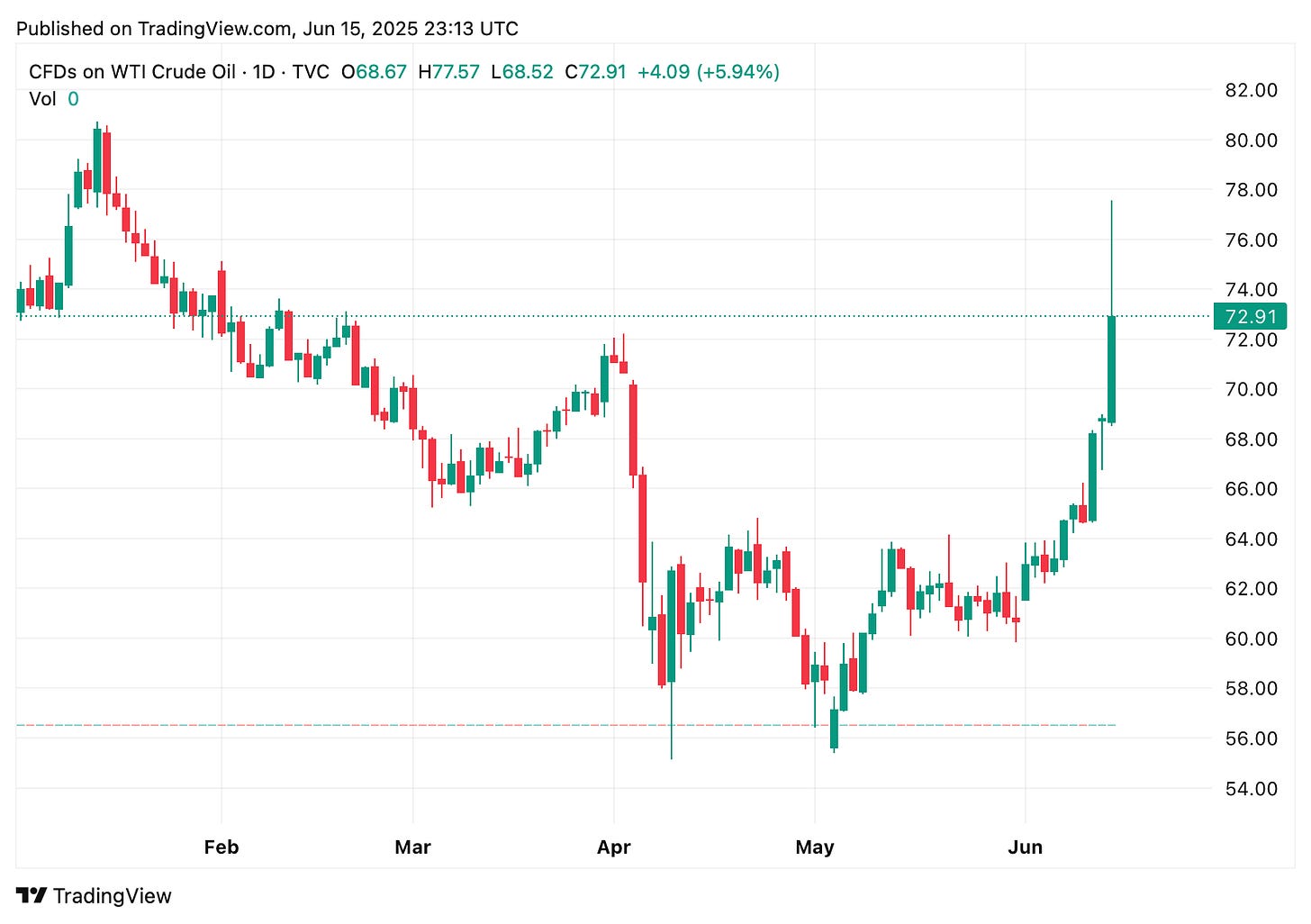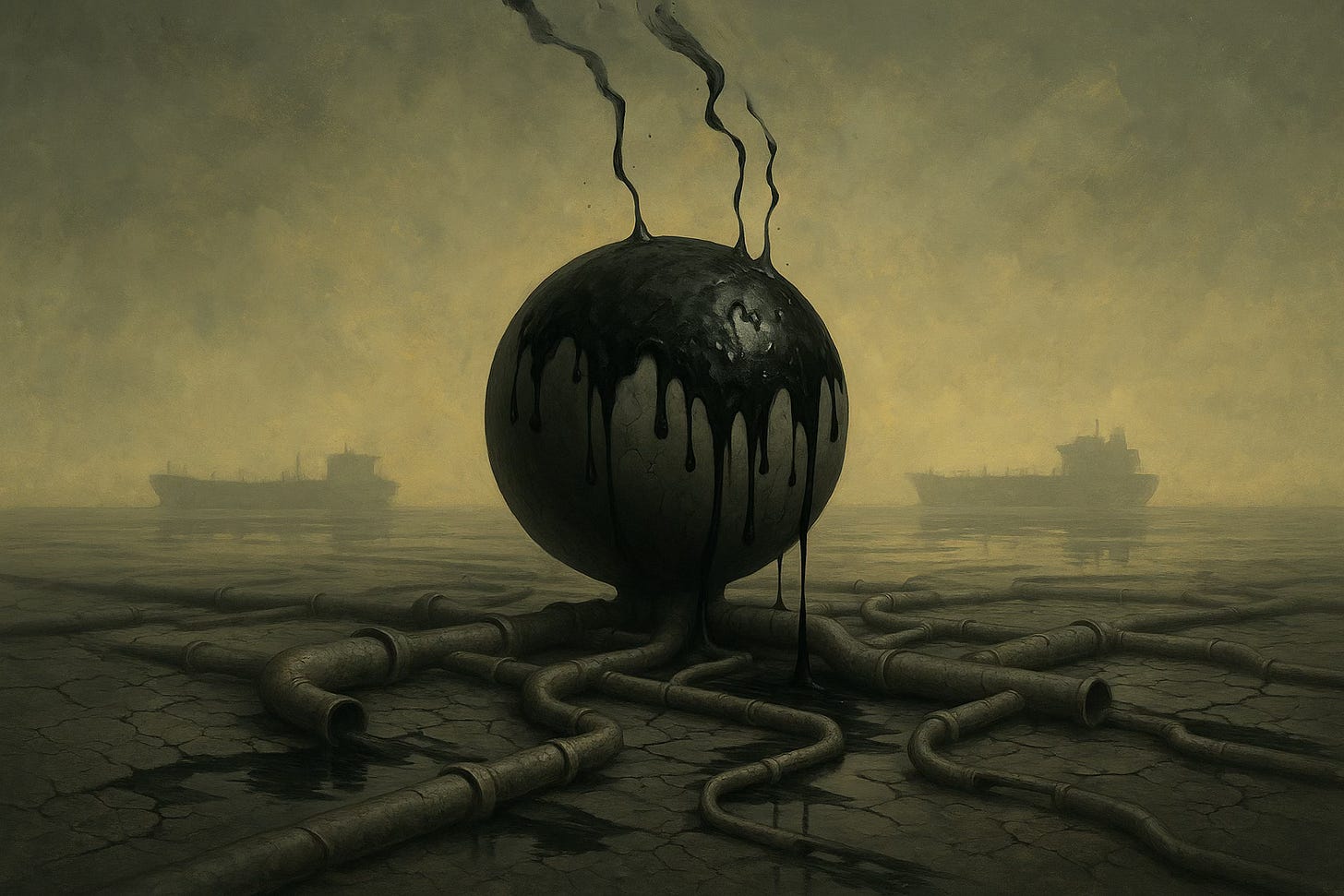Oil at Gunpoint
Missiles hit targets. Oil hits everything else.
The weekend’s fireworks weren’t just for show.
Israel’s surgical strikes on Iranian nuclear facilities have sent crude oil catapulting past $75, and suddenly everyone’s paying attention to a conflict that’s been simmering for years.
But here’s the thing about oil markets: they don’t care about your geopolitical opinions. They care about supply, demand, and the very real possibility that 20% of the world’s crude could get choked off at the Strait of Hormuz.
WTI crude jumped 5% in a single session. Brent futures gapped up 4% on Sunday evening alone. We’re looking at the biggest weekly oil candle since March 2022, and that should make you sit up and take notice.

The math is brutally simple. Iran produces about 3 million barrels per day — roughly 4% of global production. Not catastrophic on its own. But here’s where it gets interesting: the Strait of Hormuz isn’t just Iran’s pressure point. It’s the world’s.
Every day, one-fifth of global oil gets funneled through that narrow strip of water. Saudi crude, UAE crude, Kuwaiti crude. All squeezed through a single chokepoint that Iran, given enough provocation, could disrupt with terrifying ease.
JPMorgan thinks oil hits $130 if Hormuz closes. Goldman’s floating $100-plus in a sustained escalation scenario. These aren’t fringe blog predictions. These are institutional models reacting to kinetic events.
Jerome Powell is watching this closely, whether he admits it or not. Every $10 bump in oil adds 0.4% to inflation and shaves off 0.4% from GDP. The kind of scenario that kills recovery and revives the ghost of stagflation. The Fed can’t print barrels.
Gasoline hasn’t exploded — yet. Refining margins and inventories are keeping things civil for now. That won’t last forever.
Defense contractors are having a field day. Lockheed Martin up 3.7%, RTX Corporation climbing 3%, Northrop Grumman joining the party. When missiles start flying, someone has to make replacements.
Energy equities are moving too. ExxonMobil, Diamondback, Occidental — all green. Rising crude lifts margins, and investors aren’t blind. Airlines are taking the other side. Delta down 3.8%, United off 4.4%, American sliding 4.9%. Fuel costs don’t mix well with travel sentiment.
Iran’s threats to shut Hormuz aren’t new. They’ve rattled that saber for decades. But this time they’ve been hit — hard. The Shahran fuel depot in Tehran lit up. Eight million liters of daily gasoline distribution, gone. The South Pars gas field was struck, halting twelve million cubic meters of production — at least temporarily.
So the question isn’t whether Iran can block Hormuz. They can. At least for a time. The question is whether they’re desperate enough to take the hit.
Yes, the comparisons to the 1970s are already here. But they only go so far. Today’s U.S. economy uses about 0.4 barrels of oil per $1,000 of GDP. In the 1970s, it was over 1. We’re more efficient. We’re not immune.
Back then, Paul Volcker hiked rates to 20% to kill inflation. Today’s central banks would rather strangle growth than let prices run wild again. They’ve learned that lesson. Or so we hope.
Three scenarios now sit on the table. The optimistic one sees diplomacy dial down the heat. Iran and Israel step back. Oil drifts lower. Goldman’s $55 WTI target doesn’t look laughable.
The middle road? Tit-for-tat continues, but the situation avoids full combustion. Crude stays above $70, volatility persists, central banks stall. No crash, but no comfort either.
The nightmare? Regional war. Hormuz shut. Oil at $120 or more. Inflation spikes. Central banks hit the brakes. Recession follows.
Markets hate uncertainty more than bad news. Right now we’ve got both. Israel and Iran are playing a dangerous game with global energy supplies in the balance. Every escalation raises the stakes. Every de-escalation provides temporary relief.
Watch the Strait of Hormuz. Watch OPEC’s spare capacity. Watch central bank communications. Most importantly, watch what Iran does next. This isn’t just about Middle East politics anymore — it’s about whether the global economy can handle another energy shock in an already fragile environment.
The oil market is sending a clear message: the margin for error is shrinking fast. Smart money is positioning defensively while hoping cooler heads prevail.
In the end, crude oil doesn’t care about politics. It only cares about supply and demand. And right now, supply is looking increasingly fragile.


